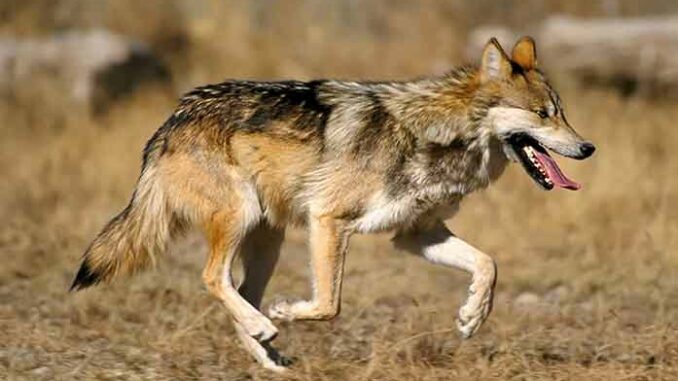
The population of Mexican wolves in Arizona and New Mexico has increased by 24 percent since last year, according to recent survey. The total number of wolves in the wild has increased to a minimum of 163 animals.
According to the Arizona Game and Fish Department, the numbers are among the findings of the Mexican Wolf Interagency Field Team (IFT). From November 2019 through January 2020, the team conducted ground counts in Arizona and New Mexico that concluded with aerial counts of Mexican wolves in January and February.
According to the IFT, the 163 wolves are distributed with 76 in Arizona and 87 in New Mexico. Last year, the team documented 131 wolves at the end of 2018, which was a 12 percent increase from 2017. This population has increased an average of 15 percent annually in the last 10 years.
In 2019, the IFT placed 12 captive-born pups into five wild dens (a process called “cross fostering”) to boost the genetic variability in the wild population. The IFT has since captured and collared two of these pups and will continue efforts in 2020 to document others that may have survived. Since the first cross-fostering of Mexican wolf pups in 2014, the IFT has documented a minimum of nine cross-fostered pups recruited into the population and currently alive. Four cross-fostered wolves have survived to breeding age, resulting in multiple litters of genetically diverse pups born in the wild. Three more cross-fostered wolves will reach breeding age in April of 2020.
2019 findings:
- At the end of 2019, there were a minimum of 42 packs of wolves (including 11 new pairs), plus 10 individuals. A wolf pack is defined as two or more wolves that maintain an established territory.
- A minimum of 21 of the 28 packs the IFT was monitoring in spring of 2019 had pups; 19 of these packs had pups that survived to the end of the year.
- A minimum of 90 pups were born in 2019, and at least 52 survived to the end of the year (a 58 percent survival rate). Average survival of Mexican wolf pups is around 50 percent.
- The IFT documented 14 mortalities in the wild population of Mexican wolves in 2019. This is a 33 percent decrease from documented mortalities (21) in 2018.
- During the aerial count, biologists captured 21 wolves and fitted them with new GPS tracking collars. This brings the number of collared wolves in the wild to 103 (63 percent of the known population). These radio collars use satellite technology to accurately record wolf locations on a frequent basis. Biologists on the IFT use this information to gain timely information about wolf behavior in the wild and assist with management of the wild population.
